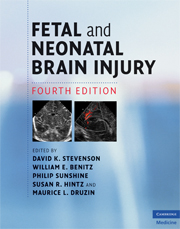Book contents
- Frontmatter
- Contents
- List of contributors
- Foreword
- Preface
- Section 1 Epidemiology, pathophysiology, and pathogenesis of fetal and neonatal brain injury
- Section 2 Pregnancy, labor, and delivery complications causing brain injury
- Section 3 Diagnosis of the infant with brain injury
- Section 4 Specific conditions associated with fetal and neonatal brain injury
- Section 5 Management of the depressed or neurologically dysfunctional neonate
- 39 Neonatal resuscitation: immediate management
- 40 Improving performance, reducing error, and minimizing risk in the delivery room
- 41 Extended management following resuscitation
- 42 Endogenous and exogenous neuroprotective mechanisms after hypoxic–ischemic injury
- 43 Neonatal seizures: an expression of fetal or neonatal brain disorders
- 44 Nutritional support of the asphyxiated infant
- Section 6 Assessing outcome of the brain-injured infant
- Index
- Plate section
- References
44 - Nutritional support of the asphyxiated infant
from Section 5 - Management of the depressed or neurologically dysfunctional neonate
Published online by Cambridge University Press: 12 January 2010
- Frontmatter
- Contents
- List of contributors
- Foreword
- Preface
- Section 1 Epidemiology, pathophysiology, and pathogenesis of fetal and neonatal brain injury
- Section 2 Pregnancy, labor, and delivery complications causing brain injury
- Section 3 Diagnosis of the infant with brain injury
- Section 4 Specific conditions associated with fetal and neonatal brain injury
- Section 5 Management of the depressed or neurologically dysfunctional neonate
- 39 Neonatal resuscitation: immediate management
- 40 Improving performance, reducing error, and minimizing risk in the delivery room
- 41 Extended management following resuscitation
- 42 Endogenous and exogenous neuroprotective mechanisms after hypoxic–ischemic injury
- 43 Neonatal seizures: an expression of fetal or neonatal brain disorders
- 44 Nutritional support of the asphyxiated infant
- Section 6 Assessing outcome of the brain-injured infant
- Index
- Plate section
- References
Summary
Routine nutritional support of the premature infant
Optimal nutritional support is critical in helping to obtain a successful outcome for the ever-increasing number of surviving small premature infants. Although it is paramount to insure that the infant receives an adequate caloric intake, the ability of the very-low-birthweight (VLBW) infant to digest, absorb, and metabolize enteral nutrients is limited. In addition, complications of prematurity, such as respiratory distress, cardiovascular instability, hemorrhagic diatheses, and an immature renal system, create a challenge to the provision of proper nutritional support.
To provide nutrition to the premature infant appropriately, one must have an understanding of the biochemical and physiologic processes that occur during the development of the gastrointestinal tract. By 28 weeks of gestation the anatomic development of the gastrointestinal tract in humans is nearly complete. Yet, as an organ of nutrition, the gut is functionally immature. Details of gastrointestinal tract development have been described previously, and are summarized inTable 44.1. Further, complications due to the incomplete development of the gastrointestinal tract in the low-birthweight infant have been well delineated by Sunshine (Table 44.2).
Enteral feeding
Gastric feeding: intermittent gavage or continuous infusion
Nasogastric (NG) feeds may be given continuously or intermittently. Intermittent feeding, also known as gavage feeding, is easy to administer, and it is possible to evaluate the gastric emptying time by checking the gastric residual before each meal.
- Type
- Chapter
- Information
- Fetal and Neonatal Brain Injury , pp. 527 - 543Publisher: Cambridge University PressPrint publication year: 2009



